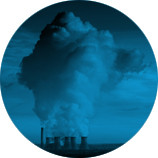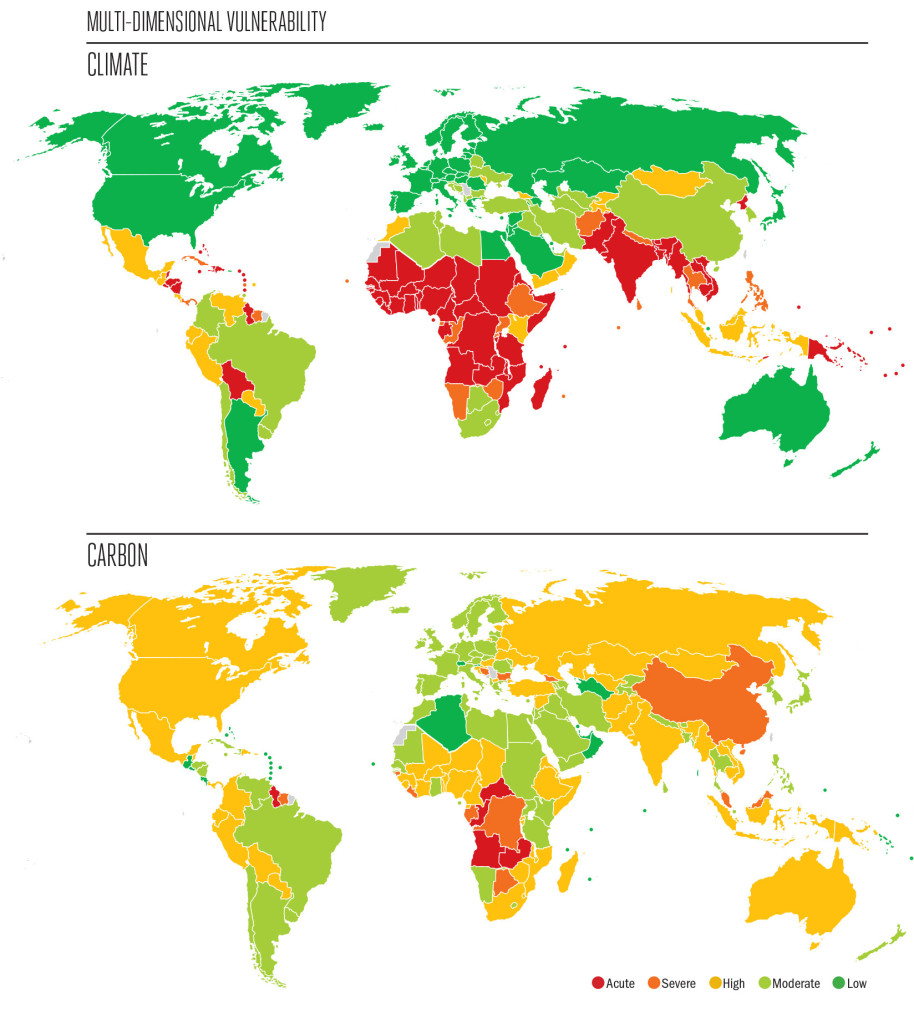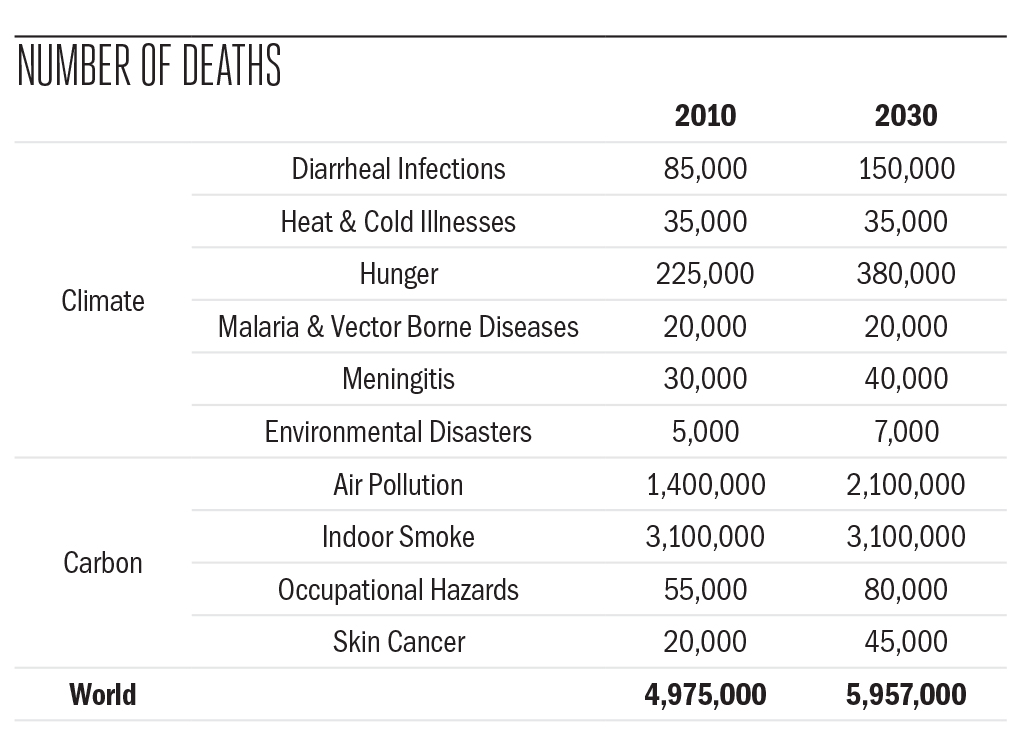
Securing a future that is powered by renewable energy can help to improve public health around the world. More renewable energy will reduce the serious health impacts of the fossil fuel and carbon intensive industries. Boosting our renewable energy supply will also reduce the impacts of climate change and their associated health burden.
Renewable energy can help save lives
Renewable energy can help to reduce the massive impact that the fossil fuel industries and climate change are already having on public health – by displacing dirty industry with a clean energy sector and reducing levels of global warming.
The fossil fuel and other dirty, high-carbon industries are estimated to cause 4.5 million deaths a year related to air pollution, occupational hazards and cancer[1]. It is also estimated that climate change – driven by burning fossil fuels – already causes 400,000 deaths on average each year, mainly due to hunger and communicable diseases that affect above all children and the elderly in the most vulnerable countries[2].
This map shows which countries are most vulnerable to the impacts of climate change and carbon-intensive industry. Source: DARA 2012
These human losses are expected to increase without significant action. Dara estimates that by 2030, the combined health impacts caused by the pollution from fossil fuels and climate change will cause 6 million deaths a year. This implies that a combined climate-carbon crisis is estimated to claim 100 million lives between now and the end of the next decade[3]. The United States, China and India in particular are expected to incur enormous losses with over 3 million deaths per year by 2030 [4].

The health threat of fossil fuels
The pollution caused by the burning of fossil fuels has been affecting global health since the industrial revolution – causing respiratory, cardiovascular diseases and cancer. Coal-fired power plants are among the worst sources of toxic air pollutants – dispersing acid gas, soot, and dust emissions huge distances from the source. The coal industry is the biggest industrial contributor to microscopic particulate pollution that penetrates deep into the lungs and bloodstream[5].
In India, between 2011 and 2012, dirty and toxic emissions from coal plants resulted in 80,000 to 115,000 premature deaths and more than 20 million asthma cases in the country[6]. In China, despite attempts to cut coal plants and reduce air pollution, over 250,000 people in the country’s 31 major cities are still expected to face premature death due to serious air pollution[7].
In the United States, coal contributes to four of the five leading causes of mortality: heart disease, cancer, stroke and chronic respiratory diseases. 50,000 deaths every year can be attributed to air pollution from coal-fired power generation[8].
Coal-fired power plants across the European Union are linked to more than 18,200 premature deaths and around 8,500 new cases of chronic bronchitis annually[9]. The negative public health impact from coal power plant pollution in Europe in 2010 – measured in decreased life expectancy – was equivalent to the damage to health from the smoking of 22 million cigarettes by European citizens every day of that year[10].
By adopting renewable energy sources, and cleaner transport systems many of these illnesses, deaths and financial costs can be avoided altogether.
Cost of health care
The severe public health impacts of burning dirty fossil fuels, like coal, lead to increased emergency room visits, hospital admissions, and lost workdays.
In India the costs associated with health impacts from coal-based emissions are up to $4.6 billion every year.[11] In China pollution from coal plants in 2011 was responsible for 340,000 hospital visits and 141 million cumulative days of sick leave[12].
In the USA economists have estimated the cost of health impacts from coal-fired power stations to be between one and six times its ‘value added’ to the national economy. In Australia, it is estimated that the adverse public health impacts from pollutants produced from coal-fired electricity generation costs $2 billion annually.[13]
Across Europe the health cost of air pollution from coal-fired power stations is $47 billion a year. In the EU approximately 5 million working days were lost in 2010 due to illnesses and disability associated with pollution from coal-fired power plants[14].
If we don’t speed up the transition to renewable energy, the USA, China and India in particular are expected to incur enormous losses. By 2030 for these three countries alone will be burdened by US$2.5 trillion in economic costs associated with death and illnesses related to high-carbon industries and climate change[15].
The climate health threat
The Intergovernmental Panel on Climate Change’s (IPCC) Fifth Assessment Report[16] included even stronger evidence from the global scientific community that climate change will exacerbate current health problems, exacerbating hunger, and increasing incidences of diseases such as malaria and diarrhea, to name a few.
Source: Dara Climate and Vulnerability Monitor 2012
The greatest health risks posed by climate change are:
- malnutrition resulting from reductions in food production,
- injury and disease due to intense heat waves and fires, and
- shifts in the timing and spatial distribution of infectious diseases[17].
The most vulnerable members of society – young children and the elderly – are the main victims.
Five key facts about climate change & health impacts [18]
- Climate change affects the social and environmental determinants of health: clean air, safe drinking water, sufficient food and secure shelter.
- Between 2030 and 2050, climate change is expected to cause approximately 250 000 additional deaths per year, from malnutrition, malaria, diarrhea and heat stress.
- The direct costs to health (i.e. excluding costs in health-determining sectors such as agriculture and water and sanitation), are estimated to be between US$ 2-4 billion/year by 2030.
- Areas with weak health infrastructure – mostly in developing countries – will be the least able to cope without assistance to prepare and respond.
- Reducing emissions of greenhouse gases through better transport, food and energy-use choices can result in improved health, particularly through reduced air pollution.
According the World Health Organisation (WHO) extreme heat, that is likely to become more frequent due to climate change, contributes directly to deaths from cardiovascular and respiratory disease, particularly among elderly people. In the heatwave of summer 2003 in Europe for example, more than 70,000 excess deaths were recorded[19].
Pollen and other aeroallergen levels are also higher in extreme heat. These can trigger asthma, which affects around 300 million people[20]. Ongoing temperature increases are expected to increase this burden.
Malaria is strongly influenced by climate, and already kills almost 800 000 people every year. The Aedes mosquito vector of dengue is also highly sensitive to climate conditions[21]. Studies suggest that climate change could expose an additional 2 billion people to dengue transmission by the 2080s[22].
By harnessing renewable energy to mitigate the impact of climate change and supporting comprehensive adaptation we can help to minimise these looming public health risks.
- Climate Vulnerability Monitor, Dara International 2012, http://www.daraint.org/wp-content/uploads/2012/10/CVM2-Low.pdf
- Climate Vulnerability Monitor, Dara International 2012, http://www.daraint.org/wp-content/uploads/2012/10/CVM2-Low.pdf, p.17
- Climate Vulnerability Monitor, Dara International 2012, http://www.daraint.org/wp-content/uploads/2012/10/CVM2-Low.pdf, p.17
- Climate Vulnerability Monitor, Dara International 2012, http://www.daraint.org/wp-content/uploads/2012/10/CVM2-Low.pdf, p.18
- Greenpeace International 2013, Silent Killers, http://www.greenpeace.org/international/Global/international/publications/climate/2013/Silent-Killers.pdf, p.5
- http://www.greenpeace.org/india/Global/india/report/Coal_Kills.pdf
- http://energydesk.greenpeace.org/2015/02/04/air-pollution-increases-risk-premature-death-chinese-cities/
- http://www.climatecouncil.org.au/uploads/d2b6cbbfff522e700c99f3c4e3c0aee0.pdf
- HEAL, The Unpaid Health Bill: How Coal Power Plants Make us Sick, 2013, http://www.env-health.org/IMG/pdf/heal_report_the_unpaid_health_bill_-_how_coal_power_plants_make_us_sick_finalpdf.pdf, p.5
- Greenpeace International 2013, Silent Killers, http://www.greenpeace.org/international/Global/international/publications/climate/2013/Silent-Killers.pdf, p.6
- http://www.greenpeace.org/india/Global/india/report/Coal_Kills.pdf
- http://energydesk.greenpeace.org/2013/12/12/map-health-impact-chinas-coal-plants/
- http://www.climatecouncil.org.au/uploads/d2b6cbbfff522e700c99f3c4e3c0aee0.pdf
- Greenpeace International 2013, Silent Killers, http://www.greenpeace.org/international/Global/international/publications/climate/2013/Silent-Killers.pdf, p.6
- http://www.daraint.org/wp-content/uploads/2012/09/EXECUTIVE-AND-TECHNICAL-SUMMARY.pdf
- IPCC Fifth Assessment Report 2014, http://www.ipcc.ch/report/ar5/
- World Health Organisation http://www.who.int/globalchange/environment/climatechange-2014-report/en/
- World Health Organisation, Climate Change and Health Fact Sheet http://www.who.int/mediacentre/factsheets/fs266/en/
- Robine JM et al., Les Comptes Rendus/Série Biologies, 2008, 331:171–78.
- World Health Organisation, Climate Change and Health Fact Sheet, http://www.who.int/mediacentre/factsheets/fs266/en/
- World Health Organisation, Climate Change and Health Fact Sheet, http://www.who.int/mediacentre/factsheets/fs266/en/
- World Health Organisation, Quantitative risk assessment of the effects of climate change on selected causes of death, 2030s and 2050s. WHO, Geneva

